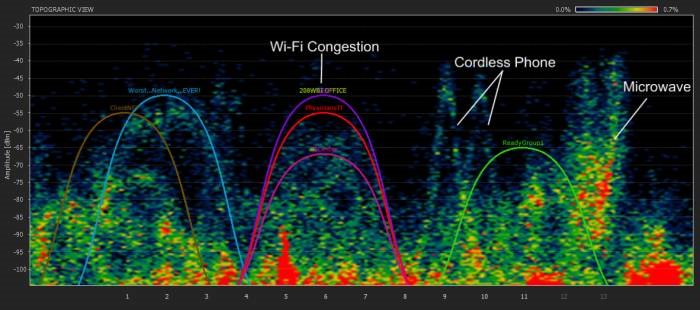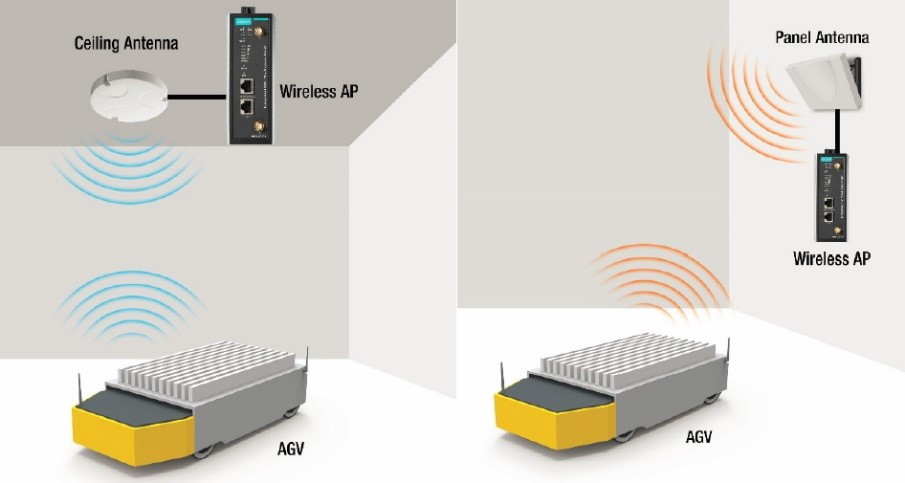Key Considerations When Planning Industrial Wi-Fi for AS/RS & AGV Systems
Modern factories are increasing the deployment of automated storage and retrieval systems (AS/RS)
and automatic gudided vehicles (AGVs) in their facilities to optimize production efficiency and reliability
Wi-Fi based technologies are emgerging as the most popular communication mehtod used in AS/RS
and AGV systems because they are flexible easy to implement scalable and futureproof. In this
articel we discuss some key points to consider when planning a Wi-Fi network for AS/RS and AGV
Modern factories are increasingly deploying automated storage and retrieval systems (AR/RS) and automatic guided vehicles (AGVs) in their
facilities to optimize production efficiency and reliability. This has led to an increase in traffic on factory floors and within industrial facilities. To be
able to monitor and control the AS/RS and AGV systems, as well as other moving equipment control center in these factories need
uninterrupted connectivity. Wi-Fi based technologies are emerging as the most popular commmunication method used in AS/RS and AGV.
systems because they are flexible, easy to implement, scalable and futureproof. In this article, we discuss some key pointsto consider when
planning a Wi-Fi network for AS/RS and AGV systems.
Plan Before Deploying a Wi-Fi Solution
Before you start installing Wi-Fi access pints (AP) in your facility, you must carfully plan the wireless network thatyou want to build. Some of
the key considerations when planning a Wi-Fi network for AS/RS and AGV systems include:
Evaluating the data rate and coverage required for your application is the first step in setting up a good Wi-Fi network. For example, the data
rates supportedin 802.11g networks are in the range of 6 to 54 Mbps. If the data coverage ccircle of an AP is smaller, a client device that
connect to the AP will benefit from a higer rate. In addition the data rate also depends on the transmitter power of the AP. Since a set of
network parameters may give different reuslts in different environments, overlapping the network coverage areas (circles) so that each coverage
circle overlaps with the previous one at a certain ratio can help clients, installed on moving equipment stay connected at all times. Restricting
the maximum number of clients that can connect per AP also help maintain stable connections.
Even when the Wi-FFi coverage is good and the RF signal is storng, you may not get good throughput. Physical obstacles, such as walls, in your
factory may be preventing some APs and client from "hearing" each other, leading to the collision of Wi-Fi signals. The RTS/CTS exchange
mechnism can be used to avoid collisions between the AP and client signals

Interference is one of the key performance inhibitors in a Wi-Fi network. Interference can be of three types:
The first two types are from Wi-Fi sources. Your Wi-Fi network ca also be affected by signals from non-Wi-Fi sources such as Bluetooth
devices and microwave ovens. You should identify such sources of interference and carefully plan the location of your APs so that you get the
maximum possible coverage for client devices

Wi-Fi networks have limited coverage, which means multiples APs need to be installed to ensure full coverage in a factory or warehouse. The
Wi-Fi client installed on moving parts of the AS/RS or on AGVs must roam from one AP to another as they move aournd the facility to maintain
theconnection. Clients typically take a short roaming recovering time (3 to 5 seconds) when they roam between APs. This is not permissible in
indutrial operations because AGVs and other moving equipment will not be able to report their location to the control center during this period
The roaming recovery time should be in the milisecond range so that the clients do not disconnect from the network and can continue to report
the stauts and location of their host when they roam from one AP to another
Selecting the right antennna type of the APs and the clients installed on moving vehicles such as AGVs is a key factor in building stable Wi-Fi
networks. The main principle to be followed when installing antennas, be it on a rack structure or moving path/direction of vehicles, is to ensure
that the radiation planes of the transmitting and receiving antennas overlap at all times. This will provide adequate coverage and reliable
communication

Some AGVs operate under harsh environmental conditions, such as cold-storage warehouses where the electrical equipment need to be able
to operate at sub-zero temperatures. Therfore, it is essntial to have isolation protection at the power input and sometimes also on the antenna
ports so that electrical interference does not damage the mobile radios.
Moxa´s Solution
The AWK Series AP/bridge/client solution offers the ffollowing capabilities that can help develop reliable wireless solutions for your AS/RS andd
AGV systems.
facilities to optimize production efficiency and reliability. This has led to an increase in traffic on factory floors and within industrial facilities. To be
able to monitor and control the AS/RS and AGV systems, as well as other moving equipment control center in these factories need
uninterrupted connectivity. Wi-Fi based technologies are emerging as the most popular commmunication method used in AS/RS and AGV.
systems because they are flexible, easy to implement, scalable and futureproof. In this article, we discuss some key pointsto consider when
planning a Wi-Fi network for AS/RS and AGV systems.
Plan Before Deploying a Wi-Fi Solution
Before you start installing Wi-Fi access pints (AP) in your facility, you must carfully plan the wireless network thatyou want to build. Some of
the key considerations when planning a Wi-Fi network for AS/RS and AGV systems include:
- Evaluating the Network Capacity and Coverage Required
Evaluating the data rate and coverage required for your application is the first step in setting up a good Wi-Fi network. For example, the data
rates supportedin 802.11g networks are in the range of 6 to 54 Mbps. If the data coverage ccircle of an AP is smaller, a client device that
connect to the AP will benefit from a higer rate. In addition the data rate also depends on the transmitter power of the AP. Since a set of
network parameters may give different reuslts in different environments, overlapping the network coverage areas (circles) so that each coverage
circle overlaps with the previous one at a certain ratio can help clients, installed on moving equipment stay connected at all times. Restricting
the maximum number of clients that can connect per AP also help maintain stable connections.
- Tackling the Hidden Node Issue
Even when the Wi-FFi coverage is good and the RF signal is storng, you may not get good throughput. Physical obstacles, such as walls, in your
factory may be preventing some APs and client from "hearing" each other, leading to the collision of Wi-Fi signals. The RTS/CTS exchange
mechnism can be used to avoid collisions between the AP and client signals

- Mitigating the Effects of Interference
Interference is one of the key performance inhibitors in a Wi-Fi network. Interference can be of three types:
- Adjacent channel interference
- Co-channel interference
- Non-Wi-Fi interfference
The first two types are from Wi-Fi sources. Your Wi-Fi network ca also be affected by signals from non-Wi-Fi sources such as Bluetooth
devices and microwave ovens. You should identify such sources of interference and carefully plan the location of your APs so that you get the
maximum possible coverage for client devices

- Ensuring Seamless Roaming for Clients
Wi-Fi networks have limited coverage, which means multiples APs need to be installed to ensure full coverage in a factory or warehouse. The
Wi-Fi client installed on moving parts of the AS/RS or on AGVs must roam from one AP to another as they move aournd the facility to maintain
theconnection. Clients typically take a short roaming recovering time (3 to 5 seconds) when they roam between APs. This is not permissible in
indutrial operations because AGVs and other moving equipment will not be able to report their location to the control center during this period
The roaming recovery time should be in the milisecond range so that the clients do not disconnect from the network and can continue to report
the stauts and location of their host when they roam from one AP to another
- Selecting and Deploying Antennas
Selecting the right antennna type of the APs and the clients installed on moving vehicles such as AGVs is a key factor in building stable Wi-Fi
networks. The main principle to be followed when installing antennas, be it on a rack structure or moving path/direction of vehicles, is to ensure
that the radiation planes of the transmitting and receiving antennas overlap at all times. This will provide adequate coverage and reliable
communication

- Protecting Against the Impact of Extreme Environments
Some AGVs operate under harsh environmental conditions, such as cold-storage warehouses where the electrical equipment need to be able
to operate at sub-zero temperatures. Therfore, it is essntial to have isolation protection at the power input and sometimes also on the antenna
ports so that electrical interference does not damage the mobile radios.
Moxa´s Solution
The AWK Series AP/bridge/client solution offers the ffollowing capabilities that can help develop reliable wireless solutions for your AS/RS andd
AGV systems.
- Reliable Networks for mobile operations
- Maximum Wi-Fi coverage
- Compact Size
- Rugged Design












